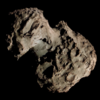astro.wikisort.org - Comet
7P/Pons–Winnecke (also known as Comet Pons–Winnecke) is a periodic Jupiter-family comet with a six-year orbit. Early calculations for the 1921 apparition suggested that the orbit of the comet might collide with Earth in June, but observations on 10 April ruled out an impact.[1] It made a very close approach to Earth in June 1927.[7] The outward migration of perihelion created impressive meteor showers in 1916, 1921 and 1927.[8]
 Contemporary 1921 illustration of Pons–Winnecke comet[1] | |
| Discovery | |
|---|---|
| Discovered by | Jean Louis Pons & Friedrich Winnecke |
| Discovery date | June 12, 1819 & March 9, 1858 |
| Alternative designations | 1858 E1, 1858 II, 1819 III, 1927c, 1933b, 1939c, 1945a, 1951c, 1964b, 1970b, 1976f, 1983b, 1989g |
| Orbital characteristics A | |
| Epoch | 2021-07-05 |
| Aphelion | 5.594 AU |
| Perihelion | 1.234 AU |
| Semi-major axis | 3.414 AU |
| Eccentricity | 0.6385 |
| Orbital period | 6.31 yrs[2] |
| Inclination | 22.363° |
| Earth MOID | 0.24 AU (36 million km) |
| Dimensions | 5.2 km[3] |
| Last perihelion | May 27, 2021[2] January 30, 2015[4][5] September 26, 2008 |
| Next perihelion | 2027-Aug-25[6] |
| Perihelion distance at different epochs[2] | |||||||
| Epoch | Perihelion (AU) | ||||||
|---|---|---|---|---|---|---|---|
| 1819 | 0.77 | ||||||
| 1875 | 0.83 | ||||||
| 1886 | 0.89 | ||||||
| 1898 | 0.92 | ||||||
| 1909 | 0.97 | ||||||
| 1921 | 1.04 | ||||||
| 1933 | 1.10 | ||||||
| 1945 | 1.16 | ||||||
The next perihelion passage is 25 August 2027[6] when the comet will have a solar elongation of 63 degrees. The last perihelion passage was 27 May 2021 when the comet had a solar elongation of 107 degrees at approximately apparent magnitude 11.[4] It passed 0.44 AU (66 million km) from Earth on 12 June 2021. Before that it came to perihelion on 30 January 2015[4] with a solar elongation of 24 degrees.[9]
Jean Louis Pons (Marseille) originally discovered the comet on 12 June 1819, it was later rediscovered by Friedrich August Theodor Winnecke (Bonn) on 9 March 1858. It is the parent body of the June Bootids of late June.
7P has an orbital period of 6.37 years. It has a perihelion of 1.3 AU and an aphelion of 5.6 AU (past the orbit of Jupiter). It passed within 0.04 AU (6.0 million km; 16 LD) of Earth in June 1927, and 0.1 AU (15 million km) in 1939;[10] but it will not come as close in the 21st century. A close approach to Jupiter in July 2037[10] will drop perihelion back to 0.982 AU.
The comet nucleus is estimated at about 5.2 km in diameter.[3]
Proposed exploration
The Jet Propulsion Laboratory proposed a flyby of the comet with a flight spare of Mariner 4 with the closest approach taking place in 1969.[11] The probe was instead used for a Venus flyby as Mariner 5.[11]
References
- Popular Science July 1921
- "7P/Pons-Winnecke". Minor Planet Center. Retrieved 2019-03-05.
- "JPL Small-Body Database Browser: 7P/Pons-Winnecke" (last observation:2014-03-28). Jet Propulsion Laboratory. Retrieved 2010-02-25.
- Seiichi Yoshida (2013-12-14). "7P/Pons-Winnecke". Seiichi Yoshida's Comet Catalog. Retrieved 2014-10-29.
- Patrick Rocher (2008-12-23). "Note number : 0039 P/Pons-Winnecke : 7P". Institut de mécanique céleste et de calcul des éphémérides. Retrieved 2012-02-19.
- "Horizons Batch for 7P/Pons-Winnecke (90000167) on 2027-Aug-25" (Perihelion occurs when rdot flips from negative to positive). JPL Horizons. Retrieved 2022-06-15. (JPL#24/Soln.date: 2021-Dec-20)
- "Record Close Comet Distances from Earth".
- Kronk, Gary W. "7P/Pons-Winnecker". Retrieved 2019-03-05. (Cometography Home Page)
- "Elements and Ephemeris for 7P/Pons-Winnecke". Minor Planet Center. Archived from the original on 2014-10-29. Retrieved 2014-10-29. (0007P)
- "JPL Close-Approach Data: 7P/Pons-Winnecke" (last observation: 2014-03-28). Retrieved 2008-03-22.
- Ulivi, Paolo; Harland, David M (2007). Robotic Exploration of the Solar System Part I: The Golden Age 1957-1982. Springer. p. 57-58. ISBN 9780387493268.
External links
- Orbital simulation from JPL (Java) / Horizons Ephemeris
- Elements and Ephemeris for 7P/Pons-Winnecke – Minor Planet Center
- 7P/Pons-Winnecke – Seiichi Yoshida @ aerith.net
- 7P – Gary W. Kronk's Cometography
- article on the nuclei of 7P, 14P, and 92P
На других языках
[de] 7P/Pons-Winnecke
Der Komet 7P/Pons-Winnecke wurde am 12. Juni 1819 von Jean-Louis Pons am Observatorium von Marseille entdeckt. Der in Bonn tätige Astronom Friedrich August Theodor Winnecke entdeckte ihn am 9. März 1858 wieder. Der zur Jupiter-Familie gehörende Komet hat eine Umlaufperiode von rund 6,4 Jahren und durchlief sein Perihel das letzte Mal am 27. Mai 2021.- [en] 7P/Pons–Winnecke
[ru] 7P/Понса — Виннеке
7P/Понса-Виннеке (7P/Pons-Виннеке) — короткопериодическая комета из семейства Юпитера, которая была открыта 12 июня 1819 года французским астрономом Жаном-Луи Понсом в Марсельской обсерватории, когда комета медленно двигалась по созвездию Льва. Он описал её как слабый диффузный объект с центральной конденсацией. Комета обладает довольно коротким периодом обращения вокруг Солнца — чуть менее 6,37 года.Другой контент может иметь иную лицензию. Перед использованием материалов сайта WikiSort.org внимательно изучите правила лицензирования конкретных элементов наполнения сайта.
WikiSort.org - проект по пересортировке и дополнению контента Википедии

